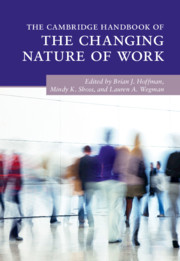Book contents
- The Cambridge Handbook of the Changing Nature of Work
- The Cambridge Handbook of the Changing Nature of Work
- Copyright page
- Contents
- Figures
- Tables
- Contributors
- Part I Introduction to the Changing Nature of Work
- 1 The Changing Nature of Work and Workers
- 2 Inappropriate Inferences from Generational Research
- 3 What Has Changed and What Has Not?
- Part II What Has Changed?
- Part III Implications for Talent Management and Impact on Employees
- Index
- References
3 - What Has Changed and What Has Not?
from Part I - Introduction to the Changing Nature of Work
Published online by Cambridge University Press: 02 April 2020
- The Cambridge Handbook of the Changing Nature of Work
- The Cambridge Handbook of the Changing Nature of Work
- Copyright page
- Contents
- Figures
- Tables
- Contributors
- Part I Introduction to the Changing Nature of Work
- 1 The Changing Nature of Work and Workers
- 2 Inappropriate Inferences from Generational Research
- 3 What Has Changed and What Has Not?
- Part II What Has Changed?
- Part III Implications for Talent Management and Impact on Employees
- Index
- References
Summary
For nearly 30 years, the business and scientific press has featured a constant stream of stories about the changing nature of work. While some organizations and occupations have changed substantially in recent years, the belief that such changes are relatively recent or relatively widespread is not well founded. First, the nature and organization of work has evolved continuously over time and the current changes are especially large. Second, there are very large sectors of the economy in which the changes in technology and the organization of work have been minimal. The belief that the nature of work is changing is in large part rooted in the tendency to mistake the brief period of economic stability and highly valued employment in the United Stats that followed the Second World War as the normal state rather than an anomaly. The nature of work is changing and will continue to change, but these changes are part of a long-term set of evolutionary changes, not a sudden or recent innovation.
Information
- Type
- Chapter
- Information
- The Cambridge Handbook of the Changing Nature of Work , pp. 42 - 66Publisher: Cambridge University PressPrint publication year: 2020
References
Accessibility standard: Unknown
Why this information is here
This section outlines the accessibility features of this content - including support for screen readers, full keyboard navigation and high-contrast display options. This may not be relevant for you.Accessibility Information
- 4
- Cited by
